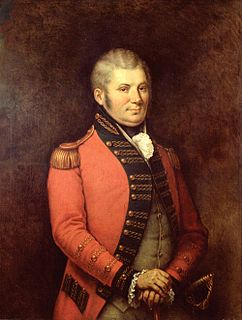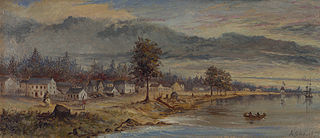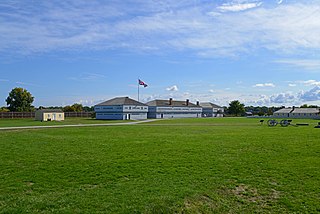
John Graves Simcoe was a British Army general and the first lieutenant governor of Upper Canada from 1791 until 1796 in southern Ontario and the watersheds of Georgian Bay and Lake Superior. He founded York and was instrumental in introducing institutions such as courts of law, trial by jury, English common law, and freehold land tenure, and also in the abolition of slavery in Canada.

York was a town and second capital of the colony of Upper Canada. It is the predecessor to the old city of Toronto (1834–1998). It was established in 1793 by Lieutenant-Governor John Graves Simcoe as a "temporary" location for the capital of Upper Canada, while he made plans to build a capital near today's London, Ontario. Simcoe renamed the location York after Prince Frederick, Duke of York and Albany, George III's second son. Simcoe gave up his plan to build a capital at London, and York became the permanent capital of Upper Canada on February 1, 1796. That year Simcoe returned to Britain and was temporarily replaced by Peter Russell.

Niagara-on-the-Lake is a town in Ontario, Canada. It is located on the Niagara Peninsula at the point where the Niagara River meets Lake Ontario, across the river from New York, United States. Niagara-on-the-Lake is in the Niagara Region of Ontario and is the only town in Canada that has a lord mayor. It has a population of 17,511 (2016).

Fort Niagara is a fortification originally built by New France to protect its interests in North America, specifically control of access between the Niagara River and Lake Ontario, the easternmost of the Great Lakes. The fort is on the river's eastern bank at its mouth on Lake Ontario. Youngstown, New York, later developed near here.

Old Fort Erie, also known as Fort Erie, or the Fort Erie National Historic Site of Canada, was the first British fort to be constructed as part of a network developed after the Seven Years' War was concluded by the Treaty of Paris (1763), at which time France ceded its territories east of the Mississippi River to Great Britain. The installation is located on the southern edge of what is now the Town of Fort Erie, Ontario, directly across the Niagara River from Buffalo, New York, United States.

Queenston is a compact rural community and unincorporated place 5 kilometres (3.1 mi) north of Niagara Falls in the Town of Niagara-on-the-Lake, Ontario, Canada. It is bordered by Highway 405 to the south and the Niagara River to the east; its location at the eponymous Queenston Heights on the Niagara Escarpment led to the establishment of the Queenston Quarry in the area. Across the river and the Canada–US border is the village of Lewiston, New York. The Lewiston-Queenston Bridge links the two communities. This village is at the point where the Niagara River began eroding the Niagara Escarpment. During the ensuing 12,000 years the Falls cut an 11 kilometres (6.8 mi) long gorge in the Escarpment southward to its present-day position.

Fort George was a military fortification in Niagara-on-the-Lake, Ontario, Canada. The fort was used by the British Army, the Canadian militia, and the United States Armed Forces for a brief period. The fort was mostly destroyed during the War of 1812. The site of the fort has been a National Historic Site of Canada since 1921, and features a reconstruction of Fort George.
Reverend Robert Addison (1754–1829) was born in Heversham, Westmorland, the 3rd son of John and Ellinor (Parkinson) of Plumbtreebank. He entered Trinity College, Cambridge, in 1777, completing his BA in 1781 and was ordained a Deacon of the Church of England in Norwich, Norfolk, on 11 March 1781.

Government House was the official residence of the Lieutenant Governor of Upper Canada and Ontario, Canada. Four buildings were used for this purpose, none of which exist today, making Ontario one of four provinces not to have an official vice-regal residence.

The Ontario Legislative Building is a structure in central Toronto, Ontario, Canada. It houses the Legislative Assembly of Ontario, and the viceregal suite of the Lieutenant Governor of Ontario and offices for members of the provincial parliament (MPPs). The building is surrounded by Queen's Park, sitting on that part south of Wellesley Street, which is the former site of King's College, which was leased from the university by the municipal government of Toronto in 1859, for a "peppercorn" payment of CAD$1 per annum on a 999-year term. The southern portion of the site was later handed over to the provincial government.

The Legislative Assembly of Upper Canada was the elected part of the legislature for the province of Upper Canada, functioning as the lower house in the Parliament of Upper Canada. Its legislative power was subject to veto by the appointed Lieutenant Governor, Executive Council, and Legislative Council.
The 1st Parliament of Upper Canada was opened 17 September 1792. Elections in Upper Canada had been held in August 1792. All sessions were held at Navy Hall in Newark, later Niagara-on-the-Lake. This parliament was dissolved 1 July 1796.

The First Ontario Parliament Buildings were built between 1829 and 1832 near Front, John, Simcoe and Wellington Streets in what was then York, Upper Canada. They served as the parliament buildings for Upper Canada, the Province of Canada, and the province of Ontario after Canadian Confederation in 1867.

The Legislative Council of Upper Canada was the upper house governing the province of Upper Canada. Modelled after the British House of Lords, it was created by the Constitutional Act of 1791. It was specified that the council should consist of at least seven members. Members were appointed for life but could be dropped for non-attendance. The first nine members of the council were appointed on 12 July 1792. The speaker was usually the Chief Justice of the Court of King's Bench. The Legislative Council was dissolved on 10 February 1841 when Upper and Lower Canada were united into the Province of Canada. Some members were reappointed to the Legislative Council of the united Province.

The Kingston Royal Naval Dockyard was a Royal Navy Dockyard from 1788 to 1853 in Kingston, Ontario, Canada, at the site of the current Royal Military College of Canada.

Amherstburg Royal Naval Dockyard was a Provincial Marine and then a Royal Navy yard from 1796 to 1813 in Amherstburg, Ontario, situated on the Detroit River. The yard comprised blockhouses, storehouses, magazine, wood yard and wharf. The yard was established in 1796 to support the Upper Canada Provincial Marine after Great Britain ceded a pre-existing shipyard on the Detroit River to the United States. Amherstburg Royal Naval Dockyard constructed four warships for the Lake Erie detachment of the Provincial Marine before and during the War of 1812. In 1813 the dockyard was abandoned and destroyed when the British retreated and never reopened. In 1928, the site was designated a National Historic Site of Canada.

Butler's Barracks was the home of Loyalist military officer John Butler (1728–1796), in what was then Newark, Upper Canada; present day Niagara-on-the-Lake, Ontario. Butler is most famous for leading an irregular military unit known as Butler's Rangers on the northern frontier during the American Revolutionary War.

Fort Mississauga National Historic Site is a fort on the shore of Lake Ontario, at the mouth of the Niagara River in Niagara-on-the-Lake, Ontario, Canada. The fort today consists of a box–shaped brick tower and historic star–shaped earthworks. The all–brick fort was built from 1814–1816 during the War of 1812, to replace nearby Fort George. It was built on a foundation of brick and stone salvaged from rubble left after retreating United States forces burned the nearby town of Newark in December, 1813. It would help in the defence of Upper Canada the following year, as part of a regional network that included Fort George, Navy Hall, and Butler's Barracks. However, the fort would not be completed until after the war.

Provincial Marine was a coastal protection service in charge of the waters in the Great Lakes, the St. Lawrence River and parts of Lake Champlain under British control. While ships of the Provincial Marine were designated HMS, they were operated in more of a coast guard manner than as a full-fledged navy. Operations were maintained and staffed by the Royal Navy. Most ships of the Provincial Marine were built on the Great Lakes.
Point Frederick is a 41-hectare (101-acre) peninsula in Kingston, Ontario, Canada. The peninsula is located at the south end of the Rideau Canal where Lake Ontario empties into the St. Lawrence River. Point Frederick is bounded by the Cataraqui River to the west, the St. Lawrence River to the south, and Navy Bay to the east. The peninsula is occupied by the Royal Military College of Canada (RMC). Several of the buildings located on Point Frederick and the site of the old naval dockyard are national historic sites. Fort Frederick, at the south end of the peninsula, is a feature of the Kingston Fortifications National Historic Site of Canada.



















